Numerical Study of Gas Breakthrough in Preferential Rocks for Underground Nuclear Waste Repositories
Abstract
1. Introduction
- The gas is dissolved in molecular form in pore water and undergoes advection following Brownian motion;
- With the accumulation of gas, the gas pressure gradually increases, and, according to the Young–Laplace equation, when the gas pressure exceeds the capillary resistance at the gas–liquid phase interface, the gas phase can push the liquid phase;
- The continuous increase in gas pressure leads to the creation of microcracks in the rock matrix, and the gas seeps into the microcracks;
- The rock is damaged, and the gas exits through the fractures.
2. Analysis of Pore Space Characteristics
2.1. Clay Rock
2.2. Granite
3. Generation and Validation of the Pore Space Model
3.1. Ideas for Model Generation
3.1.1. Binarization of Gaussian Random Field
- If , the random field exhibits weak correlation;
- If , the random field exhibits powerful correlation.
3.1.2. Combination of Two-Phase Fields
3.2. Model Validation
3.2.1. Structural Element
3.2.2. GR Operation
3.2.3. MO Operation
3.3. Model Generation of the Four Investigated Rocks
- The values were preset within the PSD range of the investigated rock;
- The PSD curve was analyzed, the porosity of each field was preset, and was calculated using Equation (12);
- Binarization of a single field was conducted and multiple fields were combined;
- The GR operation and MO operation were used to verify the generated model. If the PSD of the model differed significantly from the initial data, the modification methods included: adding or deleting a field, modifying the value of , and modifying the value of .
4. Numerical Simulation of Gas Breakthrough
4.1. Capillary-Induced Gas Transport and Breakthrough in Porous Media
4.2. Numerical Calculation Scenario for Simulation of the Gas Breakthrough Pressure
4.3. Results and Discussion
4.3.1. Boom Clay and COx Argillite
4.3.2. Statistical Analysis
4.3.3. Opalinus Clay and Beishan Granite
5. Conclusions
- The binarization on a continuous Gaussian random field is capable of representing different types of porous media by varying the threshold and the correlation length. Based on this idea, 3D pore space models of the four investigated rocks were constructed. These models do not rely on an initial definition of the pore shape and thus possess randomly formed pore space morphologies. The pore size distribution was verified through geometrical analysis using the mathematical morphology method.
- In order for the surrounding rock to not be damaged under a continuously increasing gas pressure, the gas breakthrough must occur following the two-phase gas–liquid flow. Considering this, a numerical calculation scenario based on the Young–Laplace equation and the mathematical morphology image processing method was proposed and applied to the four rock models generated in this study. Important factors related to gas transfer and breakthrough, such as the interconnected transfer path, the values of and , and the length and tortuosity of the breakthrough path, were obtained, and then the gas breakthrough pressure was calculated. The results show that the gas breakthrough pressures of the Boom clay and COx argillite are 2.62–4.11 MPa and 3.72–4.27 MPa, respectively, which are close to the experimental values reported in the literature. This supports the idea that capillary-induced gas breakthrough is possible in the Boom clay and COx argillite at gas pressures lower than the fracture threshold. Due to their low porosities, no connected pathway existed in the generated models for Opalinus clay and Beishan granite. Thus, the gas breakthrough process is more likely to occur through pathway dilation or fractures if the surrounding rocks are confronted with the constant generation and accumulation of gas and increasing gas pressure.
Author Contributions
Funding
Data Availability Statement
Acknowledgments
Conflicts of Interest
References
- Su, K.; Patrick, L. Andra’s feasibility study on deep geological disposal of high-level long-lived radioactive waste. Chin. J. Rock Mech. Eng. 2006, 25, 813–824. [Google Scholar]
- Chen, W.Z.; Lei, J.; Yu, H.D. A review of self-sealing characteristics of clay rocks under coupled thermo-hydro-mechanical conditions. Chin. J. Rock Mech. Eng. 2019, 38, 1729–1746. [Google Scholar]
- Wang, J.; Xu, G.Q.; Jin, Y.X. On the surrounding rock of high-level radioactive waste geological repository. World Nucl. Geosci. 2006, 23, 222–231. [Google Scholar]
- Frederickx, L.; Honty, M.; de Craen, M.; Dohrmann, R.; Elsen, J. Relating the Cation Exchange Properties of the Boom Clay (Belgium) to Mineralogy and Pore-Water Chemistry. Clays Clay Miner. 2018, 66, 449–465. [Google Scholar] [CrossRef]
- Conil, N.; Talandier, J.; Djizanne, H.; de La Vaissière, R.; Righini-Waz, C.; Auvray, C.; Morlot, C.; Armand, G. How rock samples can be representative of in situ condition: A case study of Callovo-Oxfordian claystones. J. Rock Mech. Geotech. Eng. 2018, 10, 613–623. [Google Scholar] [CrossRef]
- Zhang, F.; Cui, Y.-J.; Conil, N.; Talandier, J. Assessment of Swelling Pressure Determination Methods with Intact Callovo-Oxfordian Claystone. Rock Mech. Rock Eng. 2019, 53, 1879–1888. [Google Scholar] [CrossRef]
- Lauper, B.; Jaeggi, D.; Deplazes, G.; Foubert, A. Multi-proxy facies analysis of the Opalinus Clay and depositional implications (Mont Terri rock laboratory, Switzerland). Swiss J. Geosci. 2018, 111, 383–398. [Google Scholar] [CrossRef]
- Kneuker, T.; Furche, M. Capturing the structural and compositional variability of Opalinus Clay: Constraints from multidisciplinary investigations of Mont Terri drill cores (Switzerland). Environ. Earth Sci. 2021, 80, 421. [Google Scholar] [CrossRef]
- Kiuru, R.; Király, D.; Dabi, G.; Jacobsson, L. Comparison of DFN Modelled Microfracture Systems with Petrophysical Data in Excavation Damaged Zone. Appl. Sci. 2021, 11, 2899. [Google Scholar] [CrossRef]
- Wu, Y.; Li, X.-Z.; Huang, Z.; Xue, S. Effect of temperature on physical, mechanical and acoustic emission properties of Beishan granite, Gansu Province, China. Nat. Hazards 2021, 107, 1577–1592. [Google Scholar] [CrossRef]
- Wang, Z.H.; Tan, Y.L.; Li, S.M.; Wang, T.Z.; Wu, X.C. Experimental and Numerical Study on Mechanical Properties and Deformation Behavior of Beishan Granite considering Heterogeneity. Adv. Civ. Eng. 2021, 2021, 6622958. [Google Scholar] [CrossRef]
- Bonin, B.; Colin, M.; Dutfoy, A. Pressure building during the early stages of gas production in a radioactive waste repository. J. Nucl. Mater. 2000, 281, 1–14. [Google Scholar] [CrossRef]
- Davy, C.A.; Skoczylas, F.; Lebon, P.; Dubois, T. Gas migration properties through a bentonite/argillite interface. Appl. Clay Sci. 2009, 42, 639–648. [Google Scholar] [CrossRef]
- Gallé, C. Gas breakthrough pressure in compacted Fo–Ca clay and interfacial gas overpressure in waste disposal context. Appl. Clay Sci. 2000, 17, 85–97. [Google Scholar] [CrossRef]
- Ortiz, L.; Volckaert, G.; Mallants, D. Gas generation and migration in Boom Clay, a potential host rock formation for nuclear waste storage. Eng. Geol. 2002, 64, 287–296. [Google Scholar] [CrossRef]
- Marschall, P.; Horseman, S.; Gimmi, T. Characterisation of gas transport properties of the Opalinus Clay, a potential host rock formation for radioactive waste disposal. Oil Gas Sci. Technol. 2005, 60, 121–139. [Google Scholar] [CrossRef]
- Wollenweber, J.; Alles, S.; Busch, A.; Krooss, B.; Stanjek, H.; Littke, R. Experimental investigation of the CO2 sealing efficiency of caprocks. Int. J. Greenh. Gas Control 2010, 4, 231–241. [Google Scholar] [CrossRef]
- Zhao, Y.; Yu, Q. Effect of CH4 on the CO2 breakthrough pressure and permeability of partially saturated low-permeability sandstone in the Ordos Basin, China. J. Hydrol. 2018, 556, 732–748. [Google Scholar] [CrossRef]
- Zhang, D.; Ranjith, P.; Perera, M.; Ma, G. Laboratory evaluation of flow properties of Niutitang shale at reservoir conditions. Mar. Pet. Geol. 2020, 115, 104257. [Google Scholar] [CrossRef]
- Cui, L.-Y.; Ye, W.-M.; Wang, Q.; Chen, Y.-G.; Chen, B.; Cui, Y.-J. Insights into Determination of Gas Breakthrough in Saturated Compacted Gaomiaozi Bentonite. J. Mater. Civ. Eng. 2020, 32, 04020190. [Google Scholar] [CrossRef]
- Cheng, Z.; Ye, B.; Zhao, J. Investigation of the Gas Breakthrough Pressure of Cement Mortar with Different Experimental Techniques. KSCE J. Civ. Eng. 2021, 26, 325–335. [Google Scholar] [CrossRef]
- Wu, T.; Pan, Z.; Connell, L.D.; Liu, B.; Fu, X.; Xue, Z. Gas breakthrough pressure of tight rocks: A review of experimental methods and data. J. Nat. Gas Sci. Eng. 2020, 81, 103408. [Google Scholar] [CrossRef]
- Xia, Y.; Cai, J.; Wei, W.; Hu, X.; Wang, X.; Ge, X. A new method for calculating fractal dimensions of porous media based on pore size distribution. Fractals 2018, 26, 1850006. [Google Scholar] [CrossRef]
- Fan, L.; Gao, J.; Wu, Z.; Yang, S.; Ma, G. An investigation of thermal effects on micro-properties of granite by X-ray CT technique. Appl. Therm. Eng. 2018, 140, 505–519. [Google Scholar] [CrossRef]
- Wang, Y.; Feng, W.K.; Hu, R.L.; Li, C.H. Fracture Evolution and Energy Characteristics During Marble Failure Under Triaxial Fatigue Cyclic and Confining Pressure Unloading (FC-CPU) Conditions. Rock Mech. Rock Eng. 2020, 54, 799–818. [Google Scholar] [CrossRef]
- Li, Y.; Yang, J.; Pan, Z.; Tong, W. Nanoscale pore structure and mechanical property analysis of coal: An insight combining AFM and SEM images. Fuel 2019, 260, 116352. [Google Scholar] [CrossRef]
- Cao, D.; Hou, Z.; Liu, Q.; Fu, F. Reconstruction of three-dimension digital rock guided by prior information with a combination of InfoGAN and style-based GAN. J. Pet. Sci. Eng. 2021, 208, 109590. [Google Scholar] [CrossRef]
- Jiang, Z.; van Dijke, M.I.J.; Sorbie, K.S.; Couples, G.D. Representation of multiscale heterogeneity via multiscale pore networks. Water Resour. Res. 2013, 49, 5437–5449. [Google Scholar] [CrossRef]
- Tahmasebi, P.; Kamrava, S. Rapid multiscale modeling of flow in porous media. Phys. Rev. E 2018, 98, 052901. [Google Scholar] [CrossRef]
- Hakimov, N.; Zolfaghari, A.; Kalantari-Dahaghi, A.; Negahban, S.; Gunter, G. Pore-scale network modeling of microporosity in low-resistivity pay zones of carbonate reservoir. J. Nat. Gas Sci. Eng. 2019, 71, 103005. [Google Scholar] [CrossRef]
- de Vries, E.T.; Raoof, A.; van Genuchten, M.T. Multiscale modelling of dual-porosity porous media; a computational pore-scale study for flow and solute transport. Adv. Water Resour. 2017, 105, 82–95. [Google Scholar] [CrossRef]
- Lima, A.; Romero, E.; Piña, Y.; Gens, A.; Li, X. Water Retention Properties of Two Deep Belgian Clay Formations. Unsaturated Soils Res. Appl. 2012, 1, 179–184. [Google Scholar]
- Tang, C.S.; Cui, Y.J.; Tang, A.M.; Shi, B. Compression behaviors of crushed COx argillite used as backfilling material in HLW repository. Chin. J. Rock Mech. Eng. 2009, 28, 2459–2465. [Google Scholar]
- Robinet, J.C.; Yven, B.; Coelho, D.; Talandier, J. Les distributions de tailles de pores dans les argilites du Callovo-Oxfordien de lEst de la France. In Proceedings of the Transfert 2012 French Conference on the Transport Properties of Geomaterials, Ecole Centrale de Lille, Villeneuve-d’Ascq, France, 20–22 March 2012; pp. 263–272. [Google Scholar]
- Keller, L.M.; Holzer, L.; Wepf, R.; Gasser, P. 3D geometry and topology of pore pathways in Opalinus clay: Implications for mass transport. Appl. Clay Sci. 2011, 52, 85–95. [Google Scholar] [CrossRef]
- Adler, R.J. The Geometry of Random Fields; Society for Industrial and Applied Mathematics (SIAM): Philadelphia, PA, USA, 1981. [Google Scholar]
- Adler, R.J.; Taylor, J.E. Random Fields and Geometry; Springer: New York, NY, USA, 2007. [Google Scholar]
- Giles, M. Approximating the erfinv Function. In GPU Computing Gems Jade Edition; Morgan Kaufmann: Burlington, MA, USA, 2012; Volume 377, pp. 109–116. [Google Scholar]
- Matheron, G. Random sets and integral geometry. J. R. Stat. Soc. 1975, 139, 277–278. [Google Scholar]
- Serra, J. Image Analysis and Mathematical Morphology; Academic Press: Orlando, FL, USA, 1982. [Google Scholar]
- Serra, J. Image Analysis and Mathematical Morphology; Academic Press: London, UK, 1988. [Google Scholar]
- Vincent, L. Morphological grayscale reconstruction in image analysis: Applications and efficient algorithms. IEEE Trans. Image Process. 1993, 2, 176–201. [Google Scholar] [CrossRef]
- Coussy, O. Poromechanics; John Wiley & Sons: New York, NY, USA, 2004. [Google Scholar]
- Vargaftik, N.B.; Volkov, B.N.; Voljak, L.D. International Tables of the Surface Tension of Water. J. Phys. Chem. Ref. Data 1983, 12, 817–820. [Google Scholar] [CrossRef]
- Yuan, Y.; Lee, T.R. Contact Angle and Wetting Properties. Surf. Sci. Technol. 2013, 51, 3–34. [Google Scholar]
- Hildenbrand, A.; Schlömer, S.; Krooss, B. Gas breakthrough experiments on fine-grained sedimentary rocks. Geofluids 2002, 2, 3–23. [Google Scholar] [CrossRef]
- Le, T.T.; Delage, P.; Cui, Y.J.; Tang, A.M.; Lima, A.; Romero, E.; Li, X.L. Water retention properties of Boom clay: A comparison between different experimental techniques. In Unsaturated Soils: Advances in Geo-Engineering; Taylor & Francis Group: London, UK, 2008. [Google Scholar]
- Duveau, G.; M’Jahad, S.; Davy, C.A.; Skoczylas, F.; Shao, J.F.; Talandier, J.; Granet, S. Gas entry through water-saturated argillite: Experimental and numerical approaches. In Proceedings of the 45th US Rock Mechanics/Geomechanics Symposium, American Rock Mechanics Association, San Francisco, CA, USA, 26–29 June 2011. [Google Scholar]
- Andra. Référentiel du Site Meuse/Haute Marne; Technical Report C-RP-ADS-09-0007; Andra (Agence Nationale pour la Gestion des Déchets Nucléaires): Paris, France, 2009. [Google Scholar]




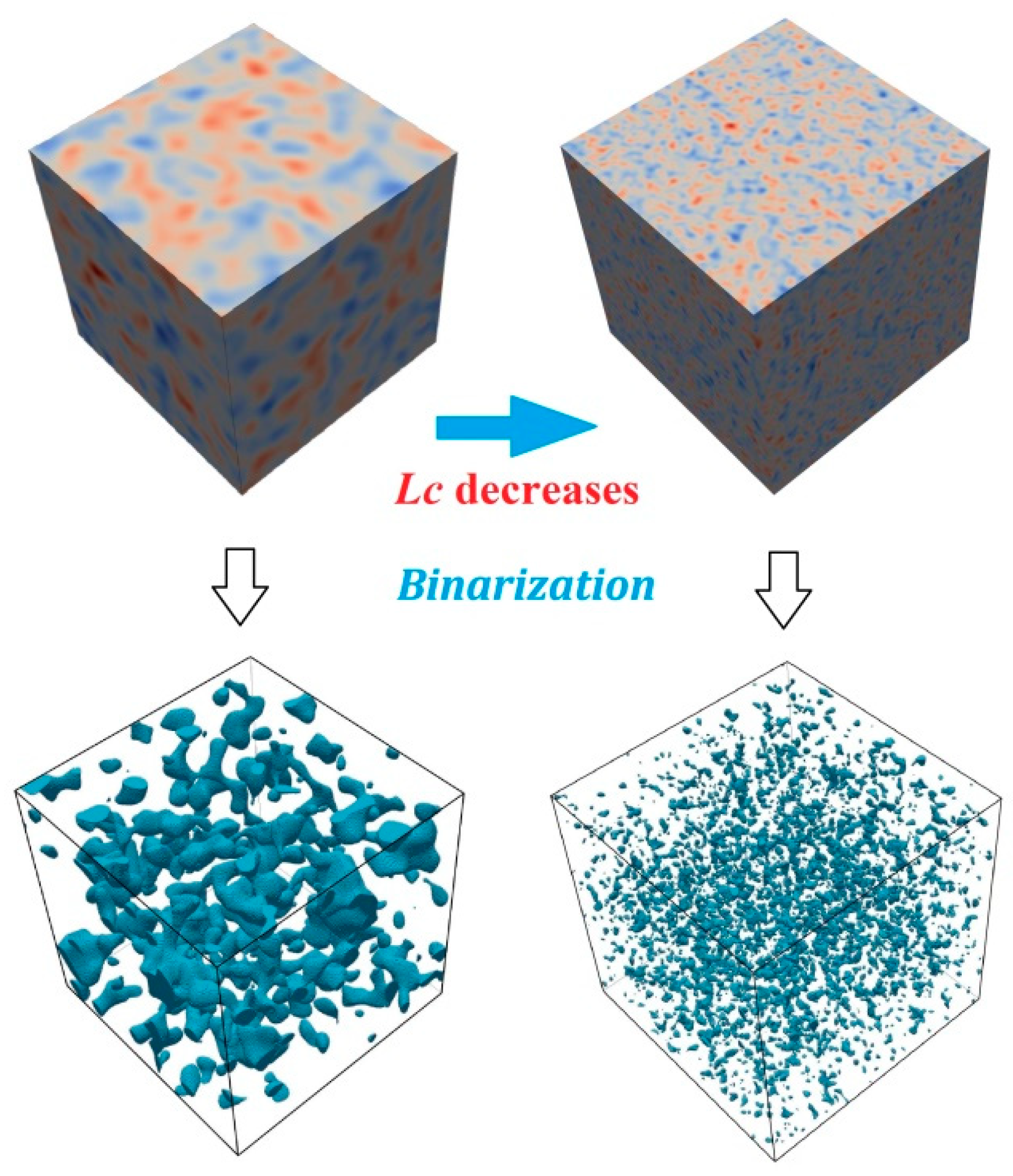
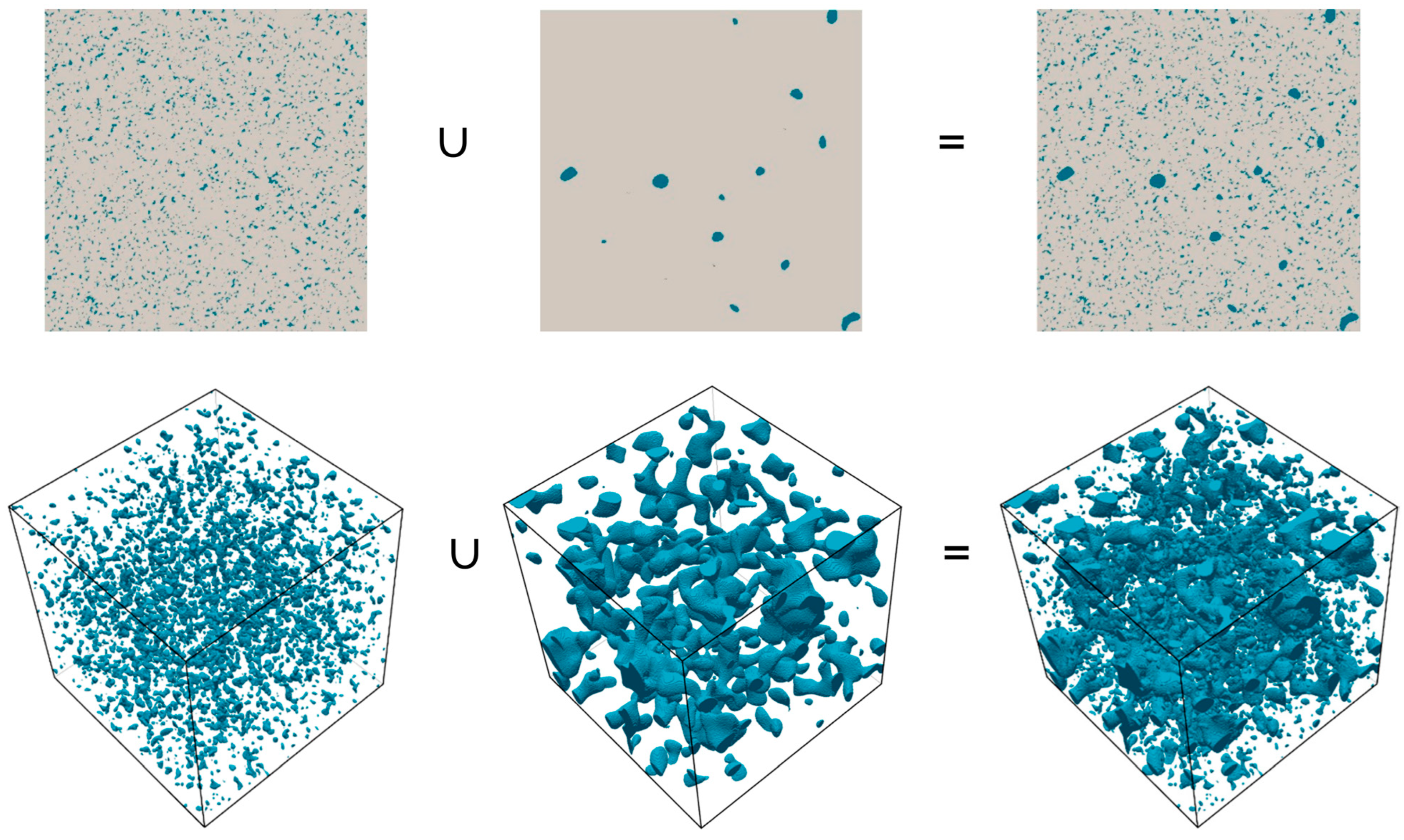

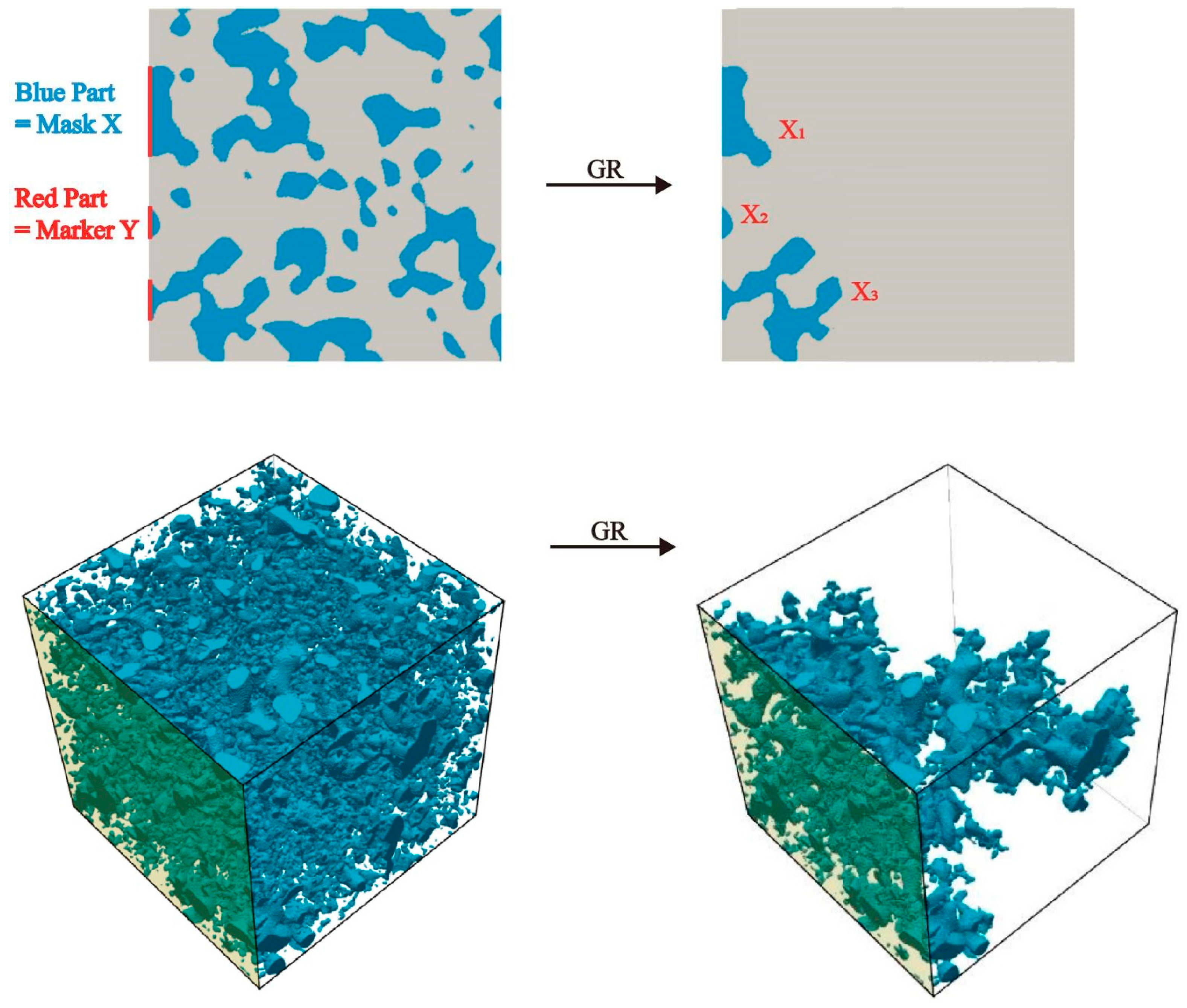
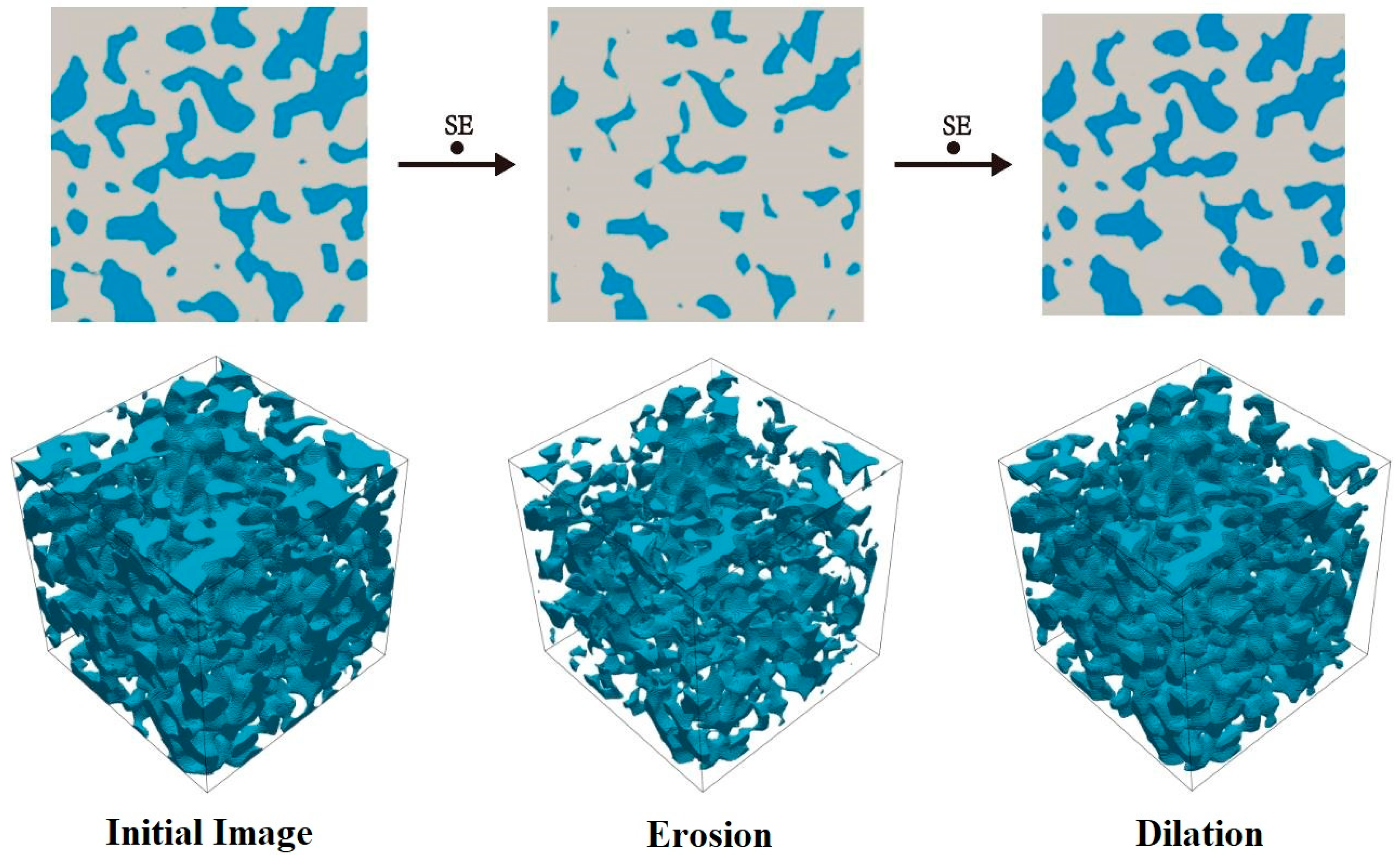
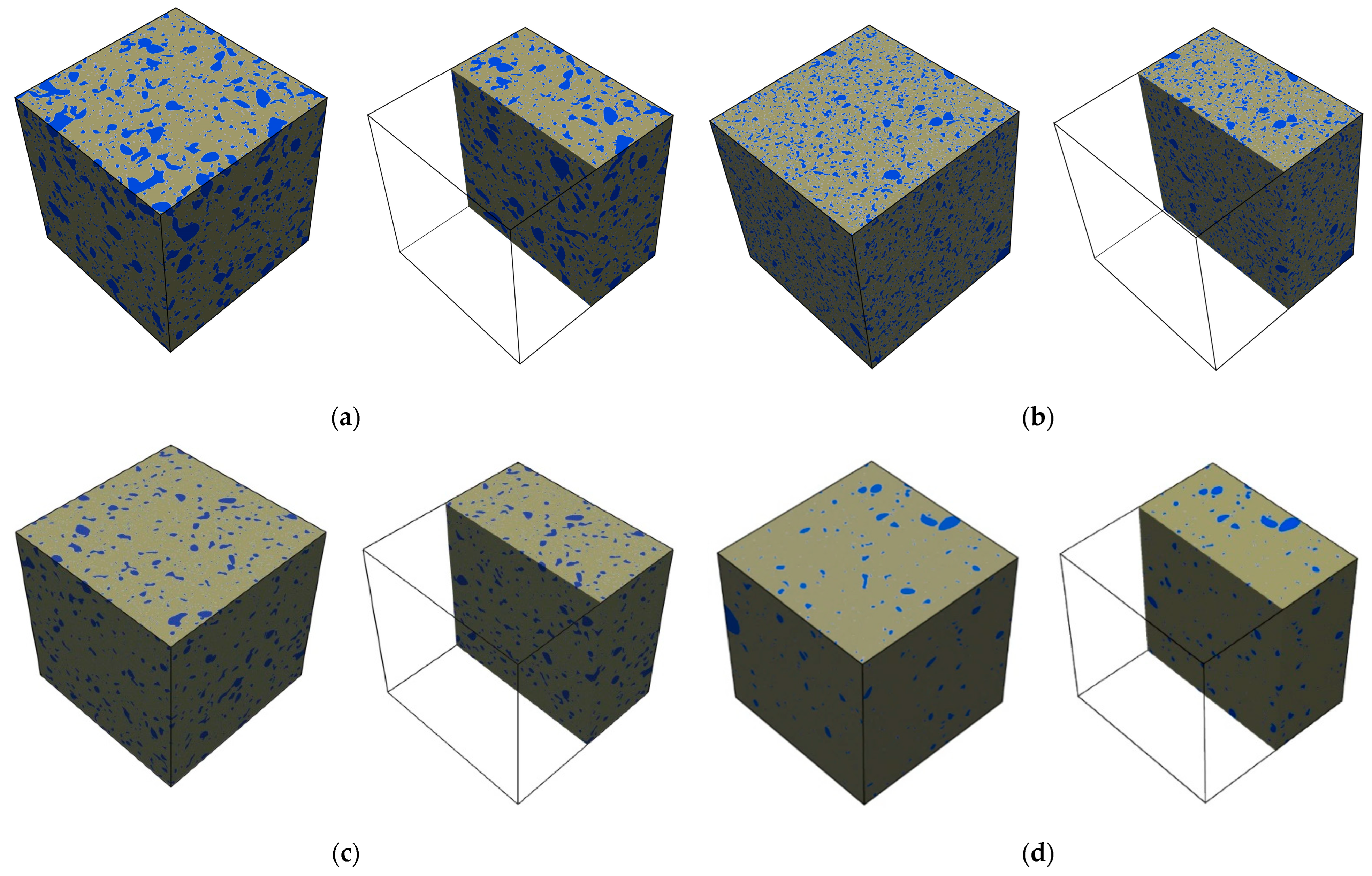

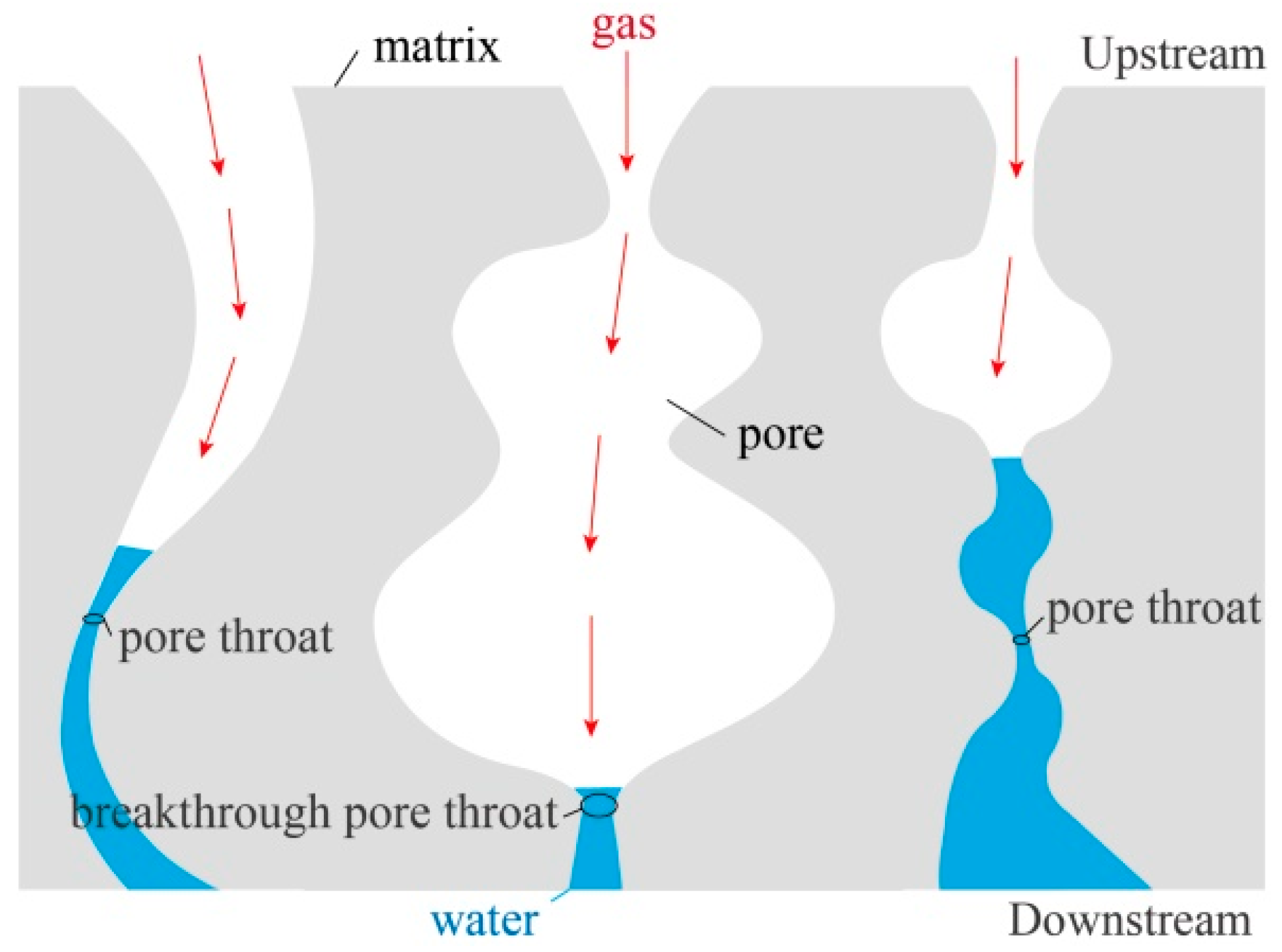

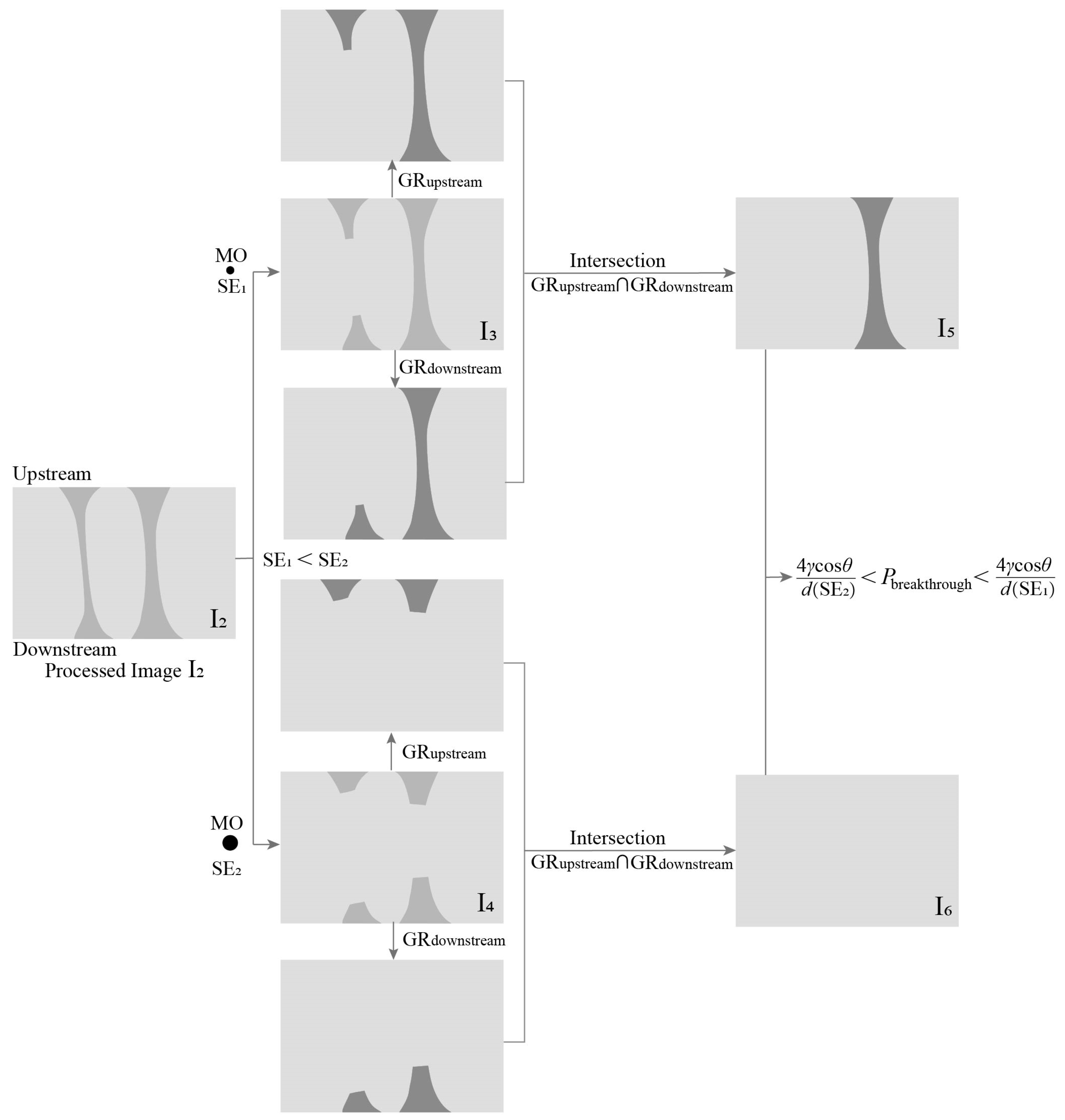
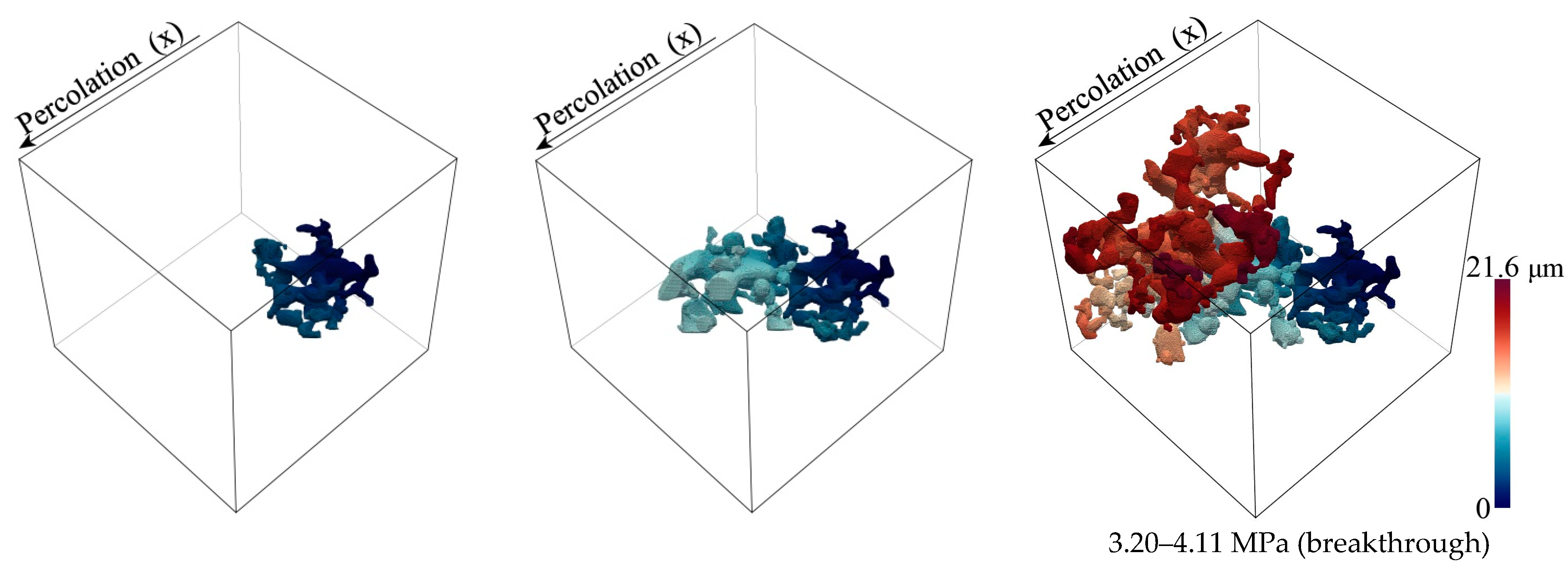
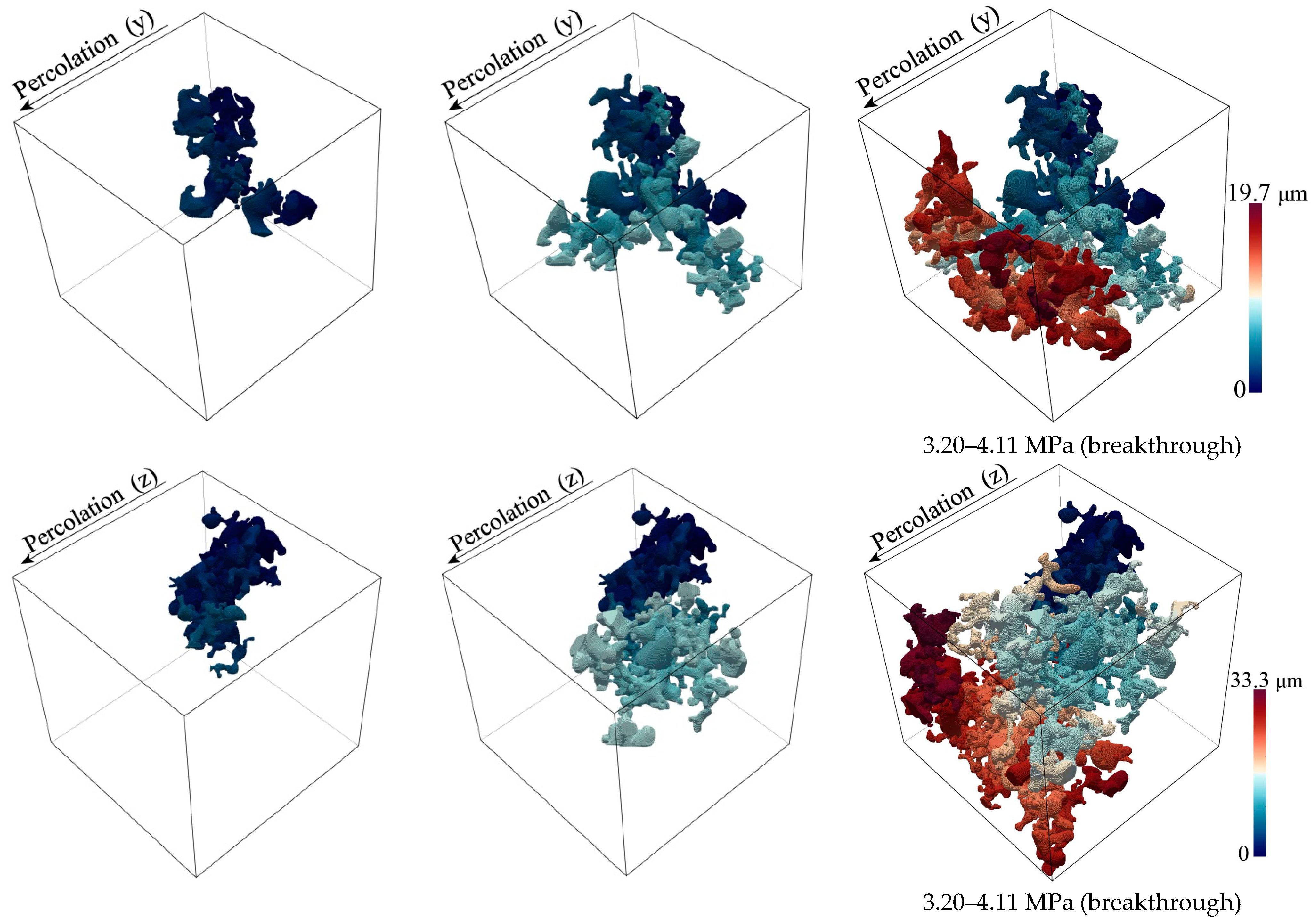
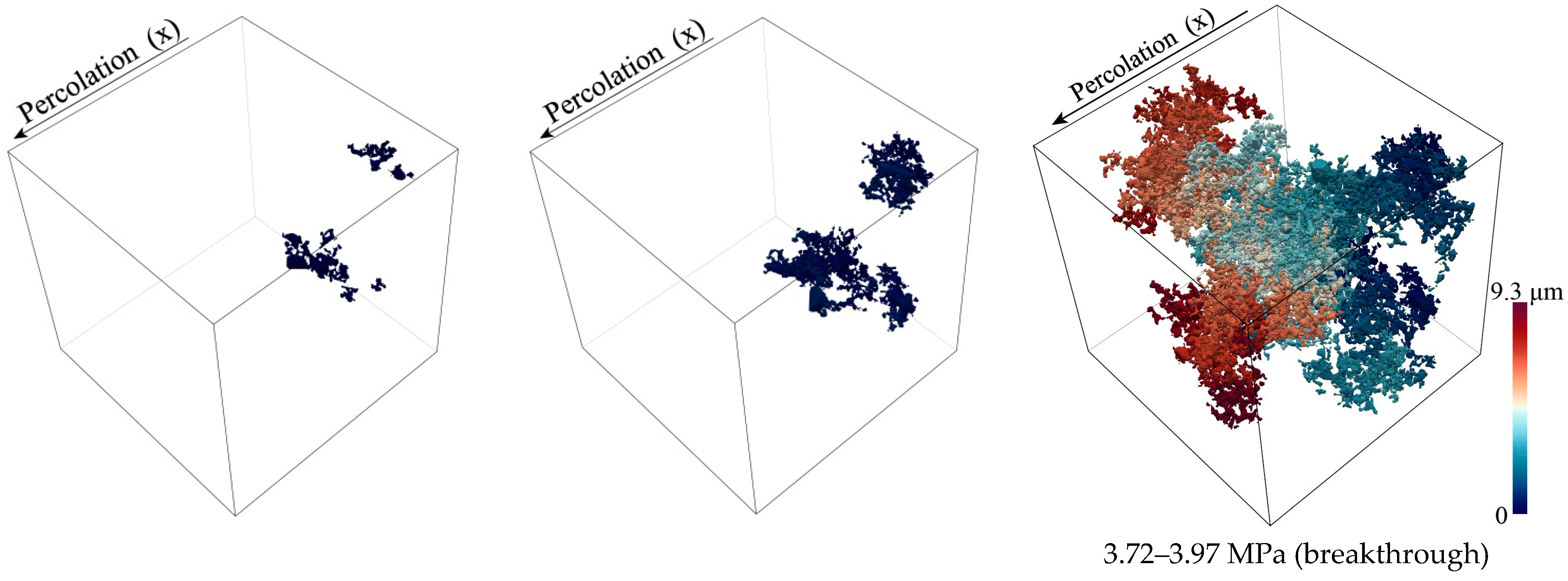
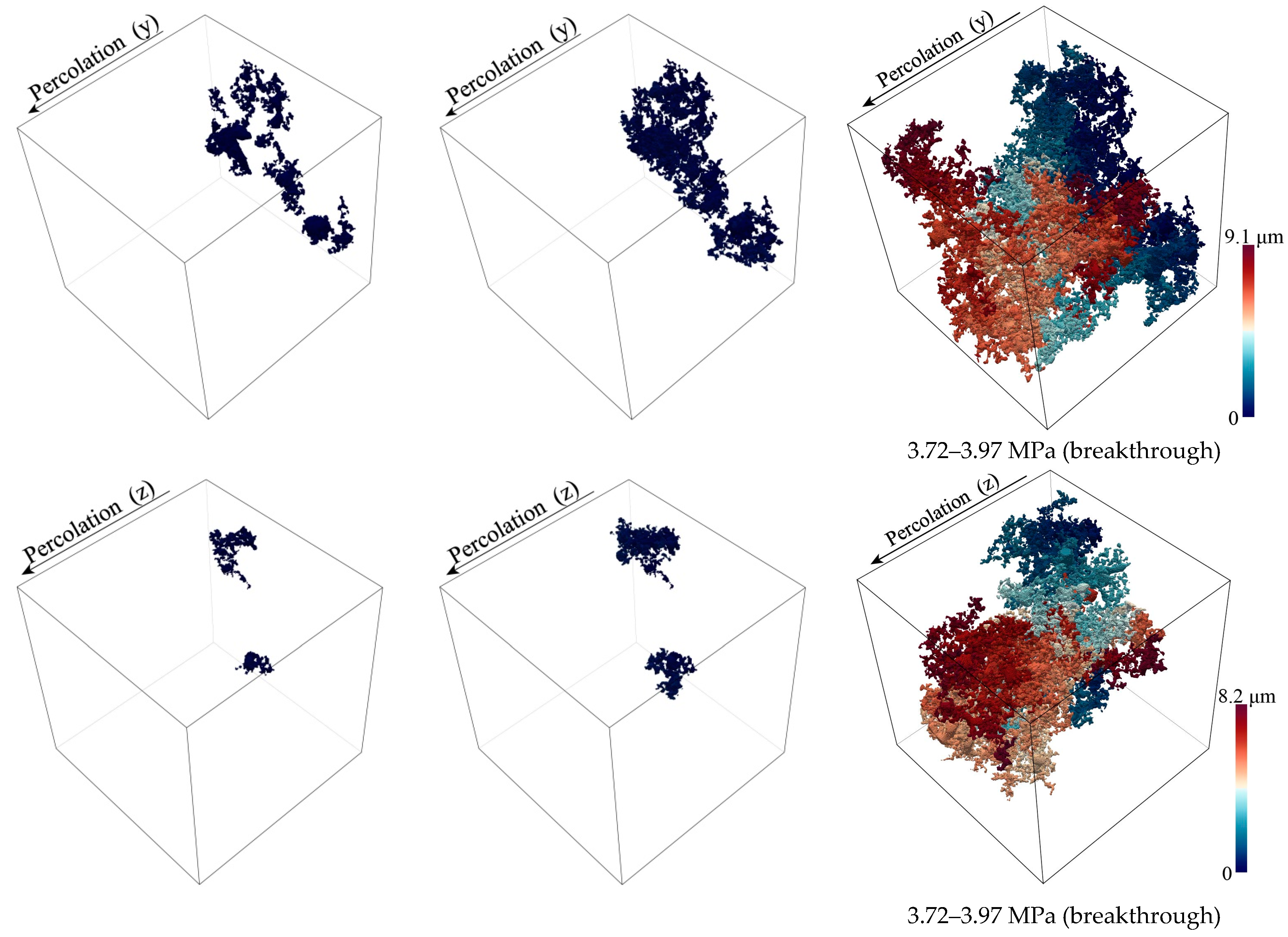

| Clay Rock | Open Porosity/% | Pore Size Distribution/μm | Main Range/μm |
|---|---|---|---|
| Boom clay | around 25 | 0.006~2 | 0.05~2 |
| COx argillite | around 20 | 0.003~10 | 0.003~0.1 |
| Opalinus clay | around 12 | 0.001~0.05 | 0.001~0.02 |
| Rock | Cube Size (μm) | Mesh | Cell Size (μm) | Values (μm) |
|---|---|---|---|---|
| Boom clay | 8 | 800 | 0.01 | 0.06, 0.08, 0.15, 0.3, 0.5, 0.7, 0.9, 1.2, 1.5 |
| COx argillite | 2 | 800 | 0.0025 | 0.004, 0.008, 0.015, 0.03, 0.05, 0.07, 0.09, 0.12 |
| Opalinus clay | 0.2 | 800 | 0.00025 | 0.002, 0.004, 0.007, 0.011, 0.015, 0.02 |
| Beishan granite | 100 | 800 | 0.125 | 0.3, 0.5, 0.8, 1.5, 2.5, 4, 6, 8.5 |
| Direction | (μm) | (MPa) | Path Length (μm) | Path Length (μm) | Tortuosity |
|---|---|---|---|---|---|
| x | 0.07, 0.09 | 3.20~4.11 | 15.4 | 21.6 | 1.93~2.70 |
| y | 0.07, 0.09 | 3.20~4.11 | 13.5 | 19.7 | 1.69~2.46 |
| z | 0.07, 0.09 | 3.20~4.11 | 17.2 | 33.3 | 2.15~4.16 |
| Direction | (μm) | (MPa) | Path Length (μm) | Path Length (μm) | Tortuosity |
|---|---|---|---|---|---|
| x | 0.0725, 0.0775 | 3.72~3.97 | 7.1 | 9.3 | 3.55~4.65 |
| y | 0.0725, 0.0775 | 3.72~3.97 | 3.8 | 9.1 | 1.90~4.55 |
| z | 0.0725, 0.0775 | 3.72~3.97 | 5.2 | 8.2 | 2.60~4.10 |
Disclaimer/Publisher’s Note: The statements, opinions and data contained in all publications are solely those of the individual author(s) and contributor(s) and not of MDPI and/or the editor(s). MDPI and/or the editor(s) disclaim responsibility for any injury to people or property resulting from any ideas, methods, instructions or products referred to in the content. |
© 2023 by the authors. Licensee MDPI, Basel, Switzerland. This article is an open access article distributed under the terms and conditions of the Creative Commons Attribution (CC BY) license (https://creativecommons.org/licenses/by/4.0/).
Share and Cite
Zhang, X.; Yin, H.; Yu, W.; Lei, Z.; Qu, J. Numerical Study of Gas Breakthrough in Preferential Rocks for Underground Nuclear Waste Repositories. Minerals 2023, 13, 393. https://doi.org/10.3390/min13030393
Zhang X, Yin H, Yu W, Lei Z, Qu J. Numerical Study of Gas Breakthrough in Preferential Rocks for Underground Nuclear Waste Repositories. Minerals. 2023; 13(3):393. https://doi.org/10.3390/min13030393
Chicago/Turabian StyleZhang, Xiang, Hang Yin, Wenjie Yu, Zhen Lei, and Juntong Qu. 2023. "Numerical Study of Gas Breakthrough in Preferential Rocks for Underground Nuclear Waste Repositories" Minerals 13, no. 3: 393. https://doi.org/10.3390/min13030393
APA StyleZhang, X., Yin, H., Yu, W., Lei, Z., & Qu, J. (2023). Numerical Study of Gas Breakthrough in Preferential Rocks for Underground Nuclear Waste Repositories. Minerals, 13(3), 393. https://doi.org/10.3390/min13030393






